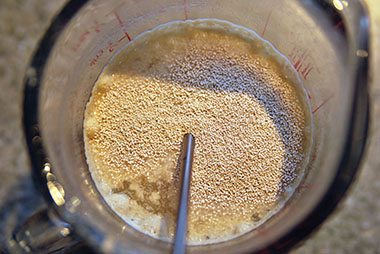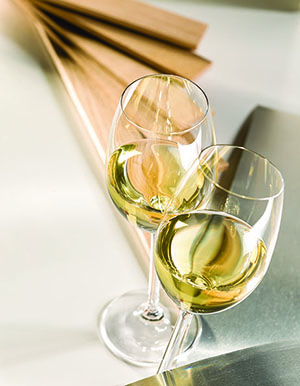
In his classic text Knowing and Making Wine, eminent French scientist Emile Peynaud remarked that the conditions for development of yeasts are the very conditions for fermentation itself. This is a way of looking at winemaking that has tremendous value for us as home winemakers. If we grow a healthy, thriving yeast population, conditions will be very favorable toward making a good wine as well.
Three important conditions for thriving yeast are managing the temperature in a suitable range, providing a rich source of energy in the form of sugars, and supporting a healthy level of required nutrients. This column focuses on the last of these; helping to guide you through the decisions required when you consider yeast nutrients. The first major decision is whether to use nutrients at all in a particular fermentation. If the answer is yes, we need to look toward which nutrients may be appropriate for the use. After that, consider when the nutrients are to be applied and how to use them.
Primary Yeast Nutrients
The most basic yeast nutrient addition is to supplement the nitrogen yeast requires for its life processes. In Wine Analysis and Production, Zoecklein et al explain that only a fraction of the nitrogen dissolved in grape must or juice can be used by yeast. This “metabolically available” nitrogen is made up of ammonia and various amino acids collectively called “free alpha-amino nitrogen” or FAN. The amino acids that provide nitrogen for yeast metabolism are referred to as primary amino acids. Daniel Pambianchi notes in Techniques in Home Winemaking that addition of yeast assimilable nitrogen (YAN) is especially important where yeast will encounter difficult conditions during fermentation; advice to help us achieve a thriving population just as Peynaud suggests. Conditions indicating the need for nitrogen include high sugar levels, presence of mold or rot, use of yeast strains with high nutritional requirements, where there is a nutrient deficiency that may not be measured, or in any circumstance where the quality of the grapes cannot be ascertained. Indeed, Pambianchi goes so far as to say, “In general, it is good practice to add yeast nutrients when making wine from grapes or fresh juice to ensure a problem-free fermentation.” The distinction regarding grapes or fresh juice is important to note. If you are instead making wine from a packaged kit, the producer of the kit will almost certainly have already analyzed for and adjusted the nitrogen level for a suitable fermentation; no further supplementation is needed.
The simplest way for most home winemakers to supplement nitrogen is with the granular material diammonium phosphate, also called DAP.
Unfortunately, there is no home test for YAN and we are left making a “best guess” decision unless analysis can be carried out by a wine laboratory. If analysis by a laboratory is available, the decision on use of a nitrogen nutrient is easier. While various authors have cited desirable levels of YAN over a wide range (from 140 mg/L or ppm to over 500 in various references cited by Zoecklein), there are some rules of thumb that prove useful. I have long considered grape must or juice to be low in YAN at less than 125 ppm, moderately supplied with native YAN from 125 to 225 ppm, and high in FAN over 225 ppm. While Pambianchi’s general recommendation still applies, musts high in FAN may not need supplementation if the selected yeast has low nutritional requirements. However, if the must is low or moderate in YAN, a nutrition program is highly recommended. This choice is strengthened if a selected yeast strain is reported as being high in nutrient demand. If you have access to a commercial wine testing laboratory or the lab at a winery, you will need to get two numbers to determine your YAN level. YAN is the sum of ammonia nitrogen and primary amino nitrogen. For totals below 225 ppm, plan to supplement. For levels above 225, keep reading for advice on which nutrients to apply. It is also recommended to increase YAN with higher Brix, although authorities differ on whether to stop at 200 mg/L or go as high as 250 mg/L.
The simplest way for most home winemakers to supplement nitrogen is with the granular material diammonium phosphate, also called DAP. The legal addition limit of ammonium salts like DAP for commercial wine in the US is 968 ppm, well above the levels needed to assure a healthy yeast population and successful fermentation. Peynaud recommends a range of addition is from 10 to 20 g per hectoliter of must, or about 0.4 to 0.8 g/gallon. If your must is low in YAN or your yeast is one with high-demand requirements, you should consider an addition of at least 0.5 g/gallon (0.5 g/3.8 L) and have enough DAP on hand to go as high as 2 g/gallon (2 g/3.8 L).

DAP alone will help develop a healthy yeast population, but may not be enough to provide a dry finish and avoid problems during fermentation. Yeasts also need the same sort of minerals and vitamins that are required for the metabolism in higher animals. Peynaud cites the need for biotin (vitamin B7), thiamine (B1), nicotinamide (the amide of B3), and others. To supplement these trace factors, we turn to products that are derived from yeasts. Yeast hulls (or ghosts) are the inactive bodies of yeasts that were terminated during their active growth phase and they are rich in typical yeast nutrients, although not much nitrogen. Yeast extract, as a solid or a syrup, concentrates the nutrients and provides some additional nitrogen. One good way to include these trace materials, yeast hulls, and ammonia nitrogen is to use a complete yeast nutrient. Sold under brand names like Fermaid K or Superfood, these formulated complete nutrients provide balanced support for yeast growth.
For several of the complete products, the maximum addition rate is limited by the amount of B vitamins that may be legally added to wine. A common rule of thumb is to limit the addition of these products to no more that 2 g/gal (2 g/3.8 L) of wine or must. Check the nitrogen level your product supplies. If the 2 g/gal (2 g/3.8 L) is not sufficient to meet the needs of your must and corresponding yeast choice, you will need to supplement with DAP. In practice, I use at least 1 g/gal (1 g/3.8 L) of complete nutrient in every wine, adding more — and potentially DAP — if I have data indicating low native YAN or I select a yeast strain that the producer reports as being high in nutrient requirements. So for me, choosing which nutrient is always complete nutrient first, with DAP as a supplement.
The timing of nutrient additions is often debated. There is no doubt that a great deal of nutrient material is depleted as fermentation proceeds, the question hinges on whether to add it early all at once and just let the fermentation go. Or, alternatively, to add it in two or more doses over a period of time. For me, it depends on how much I am going to add. I like to let the yeast get started on its growth phase and add 1 g/gal (1 g/3.8 L) of complete yeast nutrient when the Brix has dropped by about 1⁄3 from the starting value. If laboratory analysis has told me that I will also need DAP, I add it at that time as well. If a second g/gal (1 g/3.8 L) of complete nutrient product is warranted by analytical results on the must then I will add that 2⁄3 of the way through fermentation. For example, if I start at 24 °Brix, a 1⁄3 drop leaves the must at 16 °Brix. Eight more Brix to a reading of 8 °Brix represents the 2⁄3 mark for the second addition. Even without lab results, I will add a second gram per gallon (4 L) if I detect volatile reduce sulfur aromas (VRS, sulfides) when I punch down the must at about 2⁄3 of fermentation.
To assure good mixing of DAP or a complete nutrient you should disperse them in water. To avoid changing the mineral balance in my wine, I like to use distilled water, usually at room temperature. A volume of about three to five times the mass of nutrients you are adding should be sufficient for dissolving soluble components and suspending others (like yeast hulls). Pour over the top of a red must just before punching down or pumping over to assure good mixing. For white or rosé, pour the mixture into the tank or carboy and swirl or stir. Some immediate foaming may occur, so allow sufficient headspace in your fermenter to avoid making a mess.
Other Yeast Nutrients
Beyond DAP and complete nutrients used during primary fermentation, there are several specialized yeast nutrients. The most common of these is a yeast rehydration nutrient. Since a high concentration of DAP can be harmful to the yeast during rehydration, these specialized nutrients contain none of that compound. They are specially selected and derived yeast-based products. Lallemand produces several variations within the Go-Ferm brand family. Although it seems counter intuitive, applying Go-Ferm early is intended mostly to help the finish of the fermentation. Research has shown that the late stages of sugar fermentation, where some wines slow down or even fail to finish, can be sharpened and made more reliable with rehydration nutrients.
If you plan to use a product like Go-Ferm, follow the manufacturer’s instructions very carefully. Failure to do so may do more harm than good for your wine. For every gallon (3.8 L) of must or juice, you will need 1.25 g of Go-Ferm and 1 g of yeast. The usual rehydration volume is 20 times the amount of Go-Ferm, so for every gallon (3.8 L) of must you need 1.25 x 20 = 25 mL of distilled water. In a vessel two to four times the size of your mixture, warm the water to 110 °F (43 °C). Stir in the Go-Ferm. Allow the temperature of the Go-Ferm slurry to drop to 104 °F (40 °C). Stir in your yeast. You will want the combined mixture to sit for 15 to 30 minutes, but not longer. That becomes a bit complicated because you must also avoid adding your yeast to the must if there is more than an 18 °F (10 °C) difference between the yeast suspension and the must. (This is a requirement when rehydrating yeast whether or not you use Go-Ferm.) So if your must is at 68 °F (20 °C), your slurry needs to cool to 86 °F (30 °C) before mixing. If this is not happening rapidly enough on its own, you may advance it by stirring a volume of must equal to the slurry. Then wait five minutes and check the temperature and repeat as necessary. As soon as a satisfactory reading is achieved, stir the entire mixture into the must.
The final category of yeast nutrients is even more specialized. These are the specific inactivated yeasts. They are yeast-derived like yeast hulls or yeast extract but are selected and prepared for specific applications. Products like Opti-Red for red wines and OptiMUM-White for white and rosé have been introduced by Lallemand and other fermentation suppliers. The products provide a small amount of nitrogen nutrition and are classified as yeast-derived nutrients for legal compliance, but their use does not supplant your nutrient program based on the products discussed earlier.
For red wines, specific inactivated yeasts are prepared to contain high levels of yeast cell wall polysaccharides. These compounds interact with newly released polyphenols from the grapes to help stabilize color and improve mouthfeel. Using the products will also reduce harshness and any “green” character that may result from less than ideal growing conditions. On the white side, the products have a rich glutathione concentration in addition to high polysaccharides. Added near the beginning of fermentation, they help reduce the potential for brown oxidation colors and help retain esters responsible for aromas like grapefruit and passion fruit in some grape varieties. While these products may sound exotic, they are just as safe to use as traditional yeast hulls and yeast extract. I have been using them in nearly all of my wines for several years and I am very pleased with the quality of the resulting wines.
That is the sequence of yeast nutrients. Simple nitrogen compounds (DAP) and complete nutrient products for primary fermentation. Yeast rehydration nutrients to sharpen your end stages and assure a dry finish. Specific inactivated yeasts for richer mouthfeel, better color, and preservation of fresh aromas. Make a plan, gather your chosen products, and get ready for harvest 2016!






